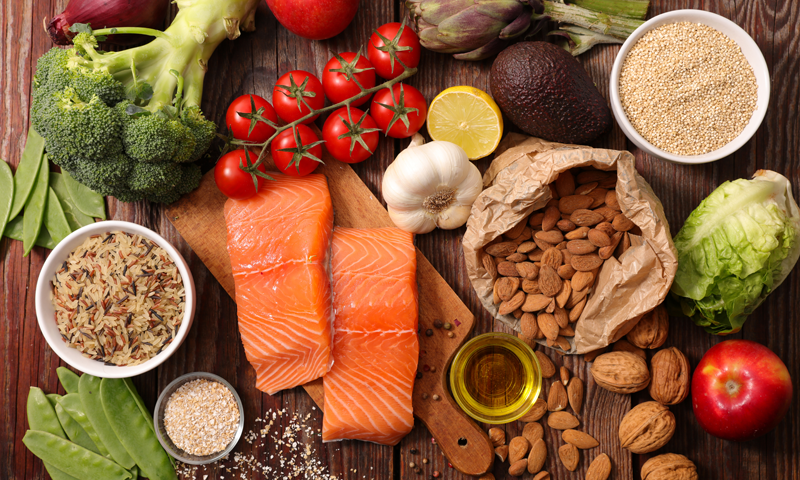
Yoga Yamas: 6 Additional Yamas to Deepen Your Yoga Practice
November 7, 2019
Yoga Practice and the Appreciation of the Body in a Forward Fold
November 21, 20195 Foods to Incorporate in Your Yoga Diet

When it comes to eating, many of us try to be environmentally conscious with our choices. Hormone-free fish, free-range chicken, vegan, organic and gluten-free products are certainly the “in” thing right now. Contrary to popular belief, a yogic or yoga diet isn’t the same as a vegan one. Instead, a yoga diet focusses on Sattvic, fresh, vegetation foods that are free from chemicals and stimulants. A yoga diet is one aspect of the practice that can be used off the yoga mat. In this article, we explore 5 foods to incorporate in your yoga diet.
1. Almonds
Almonds are rich in potassium, magnesium, vitamins, and antioxidants which help to keep the body energetic and hydrated. Also packed with iron and calcium, almonds can reduce fatigue and support heavy workouts. The nut can also prevent hunger pangs in-between meals.
2. Bananas
Available throughout the year, bananas are rich in dietary fiber and provide a filling satisfaction. They also help to regulate blood sugar during a yoga routine, as the sugar is gradually released into our system. The fruit is also rich in magnesium which blends with sodium to keep the body hydrated. This makes bananas ideal for those who practice Bikram. Bananas can also prevent bloating and muscle cramping during long yoga workouts and are an excellent source of Vitamin C, Vitamin B, and Potassium.
3. Avocados
Fresh avocado is another great yoga food. The high levels of magnesium, potassium, vitamin C, and dietary fiber provide the nutrients for the body to function smoothly. Avocados are also packed with healthy fats that fight cholesterol. However, it’s recommended that you eat avocado an hour before yoga to give the body time to absorb the nutrients.
4. Oats
Oats are ideal before a yoga workout. High in magnesium, potassium, and dietary fibers, they work to avert muscle cramping and bloating. They’re a healthy carbohydrate and take time to digest to keep you feeling full for longer.
5. Coconut Water Smoothies
Nothing beats a healthy smoothie before a yoga workout. A blend of coconut water, avocado, almonds, and banana is the ideal smoothie to add to your yoga diet. If you want to mix things up, try blending other fruits and vegetables, or adding more for a fuller stomach. For added goodness, mix the fruit and vegetable with natural coconut water.

Things to Remember
As well as eating the foods above, there are a few things to remember when it comes to a yoga diet. Thankfully, the rules of a yogic diet are pretty simple. Below, we explore them in more detail.
A Yoga Diet Should be Sattvic
The key thing to remember is that a yoga diet should be sattvic. In yogic philosophy, there are three qualities of all things in nature: Raja, Yama, and Sattva. Raja means hot, spicy, or fast; Tama means slow, lethargic, or bland; and Sattva means purity or harmony. All things have these three qualities present but in different amounts. This makes one quality dominant.
When it comes to food, rajasic foods are bitter, hot, dry, salty, or spicy. They excite the passions and overstimulate the mind. Tamasic foods are bland and include meat, alcohol, garlic, tobacco, onions, fermented foods, and overripe substances. Sattvic food is the purest group and is the most suitable for serious yogis. It nourishes the body whilst maintaining a peaceful state. In turn, this relaxes and purifies the mind, allowing it to function at its maximum potential. Following a Sattvic diet will lead to a peaceful mind and a healthy body, with a balanced flow of prana between the two.
Think Vegetarian
Meat eaters often believe a vegetarian diet is deficient in protein. However, in reality, meat-eaters get the worst quality protein from their food – the protein that is dying. Animal protein contains uric acid and other toxins that need to be broken down by the liver. While some are eliminated from the body, the rest are stored in the tissues and joints, leading to health issues such as cancer and arthritis. Uric acid also makes it harder to reach a clear, meditative state because it acts as an irritant in the blood.
Meat is one of the greatest sources of cholesterol, which contributes to senility, heart disease and hardening of the arteries. On average, meat takes three days to pass through the digestive system. For optimum health, food needs to be digested within 24 hours.
Thankfully, nuts, leafy greens, legumes, and dairy products are packed with high-quality protein. Cellulose is their main residue, which is inert and doesn’t pollute the body. Better still, it’s easily digestible and utilized by the body fast and efficiently.
Stay Away from Chemicals and Stimulants
Whenever possible, choose organic sattvic foods. Avoid stimulants such as tobacco, caffeine, alcohol, and artificial sweeteners. Not only are these substances unhealthy for the body, but they also alter the mind and affect concentration.
Eat Fresh Foods
When following a yogic diet, try to eat fresh meals. Avoid frozen, prepared, packaged, and left-over foods when possible and prepare a fresh meal instead.
Get Your Timing Right
When you train your body to eat at regular times, it better utilizes energy throughout the day as it knows when the next meal is coming. The body has cycles and functions best when they are steady and regular. This is the same with our mealtimes.
To help the body function at its best capacity, avoid food two hours before exercise or sleep. If you eat too close to exercise, energy for digestion will be used by the exercise, instead. Allowing enough time for digestion before sleep helps to keep the body healthy and the mind clear.
In Summary
So, there you have it – 5 foods to incorporate in your yoga diet. For a healthy body and mind, follow a yoga diet as well as putting on your yoga bra and hitting the mat.

